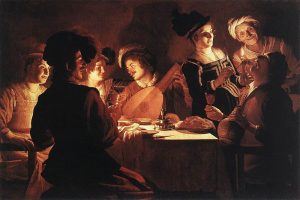Hendrick ter Brugghen and Gerard van Honthorst
Religious differences were a major consideration during the northern Netherlands’ insistent quest for independence in the sixteenth and early seventeenth centuries. Whereas Spain and the southern Netherlands were Catholic, the people of the northern Netherlands were predominantly Protestant. The prevailing Calvinism demanded a puritanical rejection of art in churches, and thus artists produced relatively little religious art in the Dutch Republic at this time (especially compared with the volume of commissions created in the wake of the Counter-Reformation in areas dominated by Catholicism.

Some artists in the Dutch Republic did produce religious art, however, Hendrick ter Brugghen (1588-1629) of Utrecht, for example, painted Calling of Saint Matthew in 1621 after returning from a trip to Italy, selecting as his subject a theme Caravaggio had painted for the church of San Luigi dei Francesi in Rome. The moment of the narrative chosen and the naturalistic depiction of the figures echo Caravaggio’s work. But although ter Brugghen was an admirer of the Italian master, he dispensed with Caravaggio’s stark contrasts of dark and light and instead presented the viewer with a more colorful palette of soft tints. Further, the Dutch painter compressed the figures into a small but well-lit space, creating an intimate effect compared with Caravaggio’s more spacious setting.

Typical of 17th century Dutch genre scenes is Supper Party by Gerrit van Honthorst. In this painting, Honthorst presents an informal gathering of unidealized figures. While a musician serenades the group, his companions delight in watching a young woman feeding a piece of chicken to a man whose hands are both occupied – one holds a jug and the other a glass. Honthorst spent several years in Italy, and while there he carefully studied Caravaggio’s work. The Italian artist’s influence surfaces in the mundane tavern setting and the nocturnal lighting of Supper Party. Fascinated by nighttime effects, Honthorst frequently placed a hidden light source in his pictures and used it as a pretext to work with dramatic and starkly contrasting dark and light effects.
Seemingly lighthearted genre scenes were popular in Baroque Holland, but Dutch viewers could also interpret them moralistically. For example, Supper Party can be read as a warning against the sins of gluttony (represented by the man on the right) and lust (the woman feeding the glutton is likely a prostitute with her aged procuress at her side). Or perhaps the painting represents the loose companions of the Prodigal Son (Luke 15:13)—panderers and prostitutes drinking, singing, strumming, and laughing.[1]
- Fred S. Kleiner, Gardner’s Art Through the Ages: The Western Perspective, vol. 1, 15th ed., (Boston: Cengage Learning, 2010), 617-619 ↵

